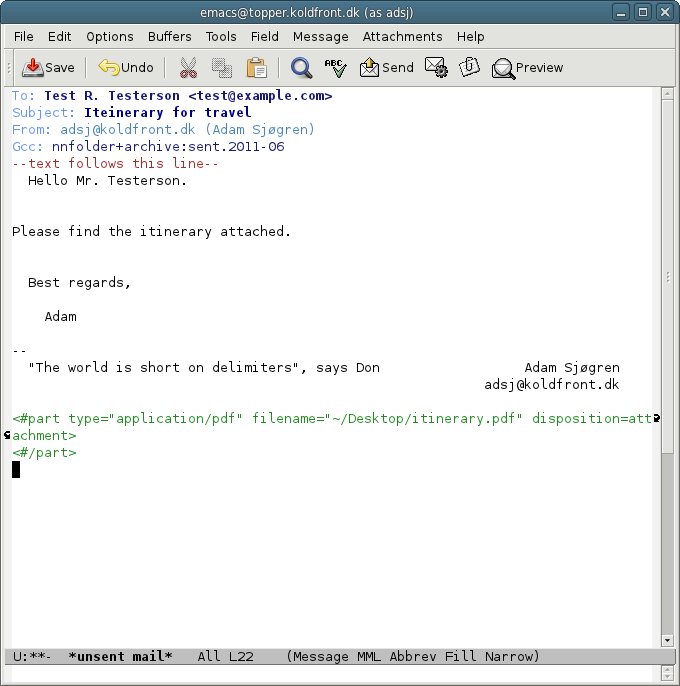Gnus email basic usage
Table of contents
Get email
As already mentioned, you ask Gnus to get new email by pressing
g. You can configure a demon to do that
regularly, if you'd like.
Reading email
When you see a group you would like to read, you move the cursor
to the group and press SPC. This will take you from the *Group*
buffer, with the list of groups, to a *Summary* buffer for the
particular group in question.:

To exit a *Summary* buffer, use q.
When you read an email, it is marked "read", and it won't show
up in the *Summary* buffer the next time you enter
the group. This is how newsgroups usually work, and it helps you
keep up with email¹: either you do
something about it right away or you tick it for later
handling. If you tick an email, using !, the email
will be shown in the *Summary* the next time you
enter the group, even though you already read it. If you want
to mark a read email as unread, the command is M-u.
Moving emails is done manually with B m (or you can
set up
splitting and respool according to your rules using B
r), and you can delete an email (entirely) by using
B DEL in the *Summary* buffer.
Writing email
In the summary buffer, you can reply to the author of an email
with r (no quoting of the email) and R
(email is quoted), and you can reply to all by using
f or F respectively:

Be sure to remember to trim unnecessary parts of the quoted text, and to interleave your answers so they come after the questions.
To write an entirely new email you type m either in
the *Group* or a *Summary* buffer. To
forward an email you have received, use C-c C-f.
To send the email, you use C-c C-c. If you want to
keep the email as a draft and don't want to send it right away,
save it using C-x C-s. If you want to abandon the
email you were writing all together, simply kill the buffer
C-x k.
Outgoing emails are automatically archived in a local nnfolder-group per month - you can see this when you start an email by looking at the Gcc: header.
If you want a signature, simply create a file called
~/.signature and Gnus will automatically include it
in the email when you start writing one:

To attach files you go C-c C-m f and then follow
the prompts:

Done
When you are done reading email, remember to quit Gnus by
pressing q in the *Group* buffer. Gnus will then
save its files, making it safe to close Emacs afterwards.
There is much more to the interface of Gnus, but this hopefully gets you started. Do consult the menus and the manual for more.
Further reading...
Beginning of the Gnus email tutorial.
Topics to cover as time permits:
- Basic usage
- IMAP
- Spam filtering
- Address book (bbdb)
- Searching
- Prompting (expert user)
- Encryption (gpg)
- Scoring
- Posting styles
- Automatically fetching email (demon)
- Ad-hoc accessing of emails (foreign servers)
Contact
If you have any comments, ideas or corrections, don't hesitate to email me.